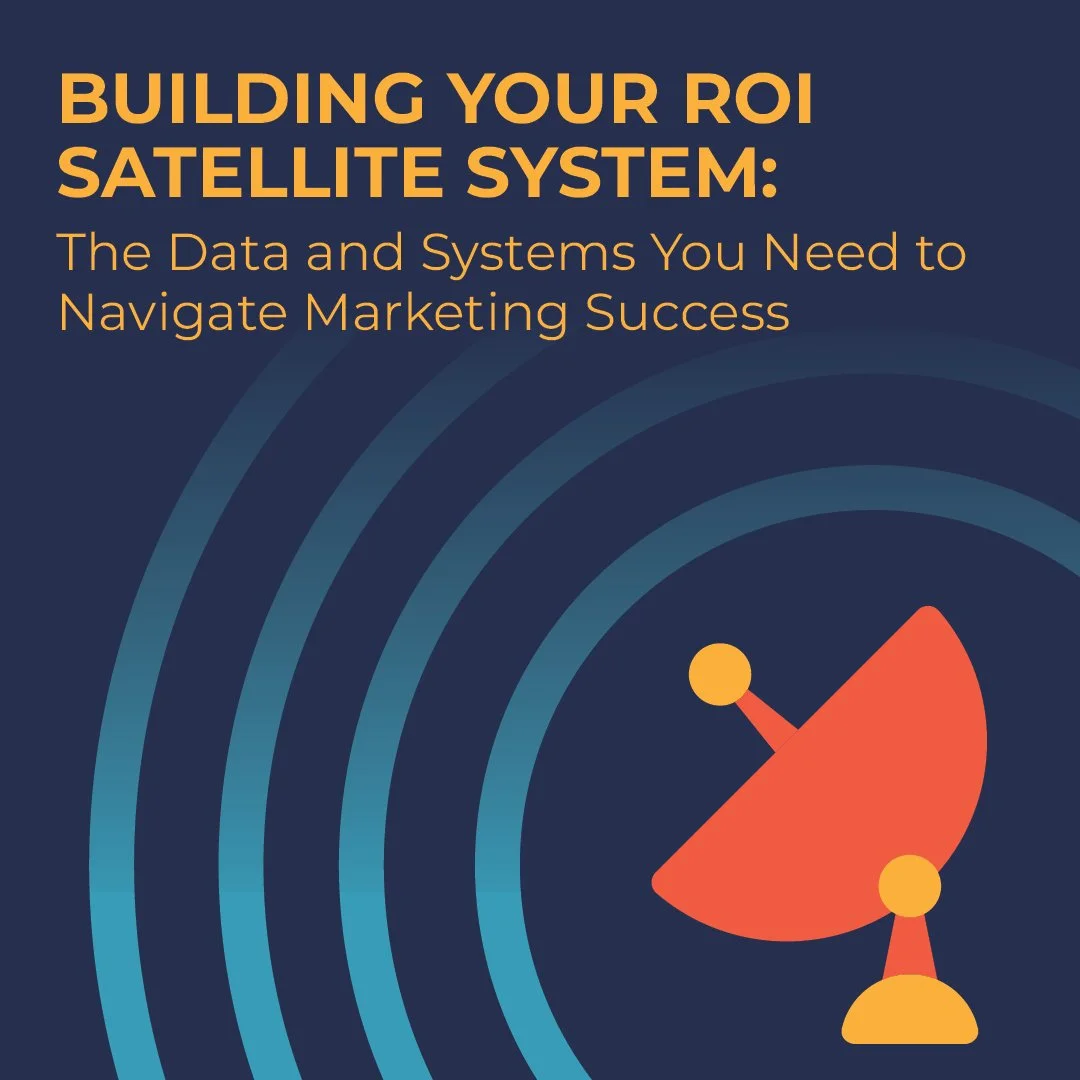Building Your ROI Satellite System: The Data and Systems You Need to Navigate Marketing Success
Written by Sarah Spatafora, Media Director
October 14, 2025
In our last post, we made the case that marketing ROI should act like a GPS, not a rearview mirror. A GPS doesn’t just confirm you’ve arrived; it guides you in real time. But a GPS can’t function without satellites – signals from multiple sources that triangulate your position and guide you as conditions change. Similarly, ROI needs a connected network of data systems to provide the real-time, actionable guidance marketers need to navigate complex customer journeys and dynamic campaigns.
The Role of Integrated Data Systems in Modern Marketing
A common obstacle is data silos. Website analytics sit in one platform, customer records live in another, and campaign data is scattered across ad tools. This fragmentation creates blind spots, showing only fragments of the journey – a spike in clicks here, a burst of form fills there. This makes it difficult to connect these actions to meaningful outcomes like enrollment or membership activation. Without a unified view, marketers react to isolated signals, miss the full story, and delaying course corrections. This weakens ROI’s ability to serve as a GPS for your investments and strategy.
Building Your "Satellite Network": Key Data and Technology Components
A high-performing ROI GPS depends on a robust “satellite network” of connected technologies and disciplined data practices that turn raw signals into coordinated action.
Customer Relationship Management (CRM)
Is the record keeper and relationship hub.
Centralizes contact details and tracks leads, conversions, and lifecycle stages across touchpoints.
Usually resides with the client (e.g., Salesforce, HubSpot, Dynamics 365, Slate, Ellucian) as the system of record.
Linking campaign data to the CRM gives leaders a clear line of sight from first click or inquiry to application, enrollment, purchase, or membership.
This visibility confirms what’s working and flags friction points (e.g., drop-offs between a form fill and an application) so teams can adjust mid-campaign.
The CRM is the foundation for proving ROI and guiding timely course corrections.
Marketing Automation Platform
Is the campaign engine that moves people forward.
Orchestrates emails, ads, landing pages, SMS reminders, and tracks engagement.
Personalizes outreach using CRM data (e.g., new lead vs. returning member) and triggers next steps automatically.
Surfaces mid-campaign signals such as a drop in webinar registrations or rise in abandoned forms so teams can adjust messaging, timing, or budget before momentum is lost.
Typically, client-owned with agency access for workflow builds and optimization.
Common platforms: HubSpot Marketing Hub, Marketo Engage, Salesforce Pardot/MCAE, ActiveCampaign.
Analytics Platforms
Are the dashboard and map for the marketing journey.
Reveal where traffic originates and what people do next such as reading a blog, clicking an ad, downloading a guide, or registering for an event.
Connect the dots across channels (ads, email, social, web) to reveal the full path to outcomes, not just the last click.
Focus attention on what’s driving true results (e.g., enrollments) vs. vanity metrics (clicks, impressions).
Highlight early-warning signs or trends like rising page views without conversions or drop-offs during sign-up so you can intervene before results suffer.
Examples: Google Analytics 4 (GA4), Adobe Analytics.
Ad and Social Platforms
Act as specialized satellites for individual media channels.
Their native dashboards show channel-level performance; when integrated with your CRM and analytics, they reveal each channel’s contribution to the entire journey, not just the last touch.
This connection transforms siloed reports into a unified GPS view of cross-channel performance.
Examples: Google Ads, LinkedIn Ads, Meta Ads Manager, Google Campaign Manager, programmatic platforms.
AI and Machine Learning
Is the “co-pilot” sitting atop CRM, automation, and analytics.
Spots patterns in past behavior to predict which leads are likely to apply, enroll, or buy and who may drop out.
Recommends the next-best message, offer, or channel for each segment.
Flags outperforming channels or creative and can recommend, or even automate, budget shifts mid-campaign.
Helps teams act faster and more confidently.
Examples: Salesforce Einstein, Adobe Sensei, HubSpot AI tools.
Data Hygiene and Governance
Good data in = good decisions out. Outdated, duplicate, or inconsistent records produce misleading dashboards and unreliable AI guidance.
Standardization matters. Consistent field names and formats (e.g., dates, phone numbers) enable systems to “speak the same language.”
Routine maintenance pays off. Cleaning duplicates, fixing errors, and keeping permissions current prevent wasted ad spend, compliance risks, and inaccurate reports.
Reliable data keeps real-time dashboards and AI recommendations trustworthy.
Putting It All Together
When these components work together, marketers gain a true ROI GPS that’s able to navigate with clarity and confidence at every stage of the customer journey. Few organizations start with the entire satellite network in place, and that’s okay. Most already have strong individual pieces like a CRM or an analytics platform, however gaps in integration or data quality can obscure the full picture and slow progress.
That’s where LMO comes in. We help clients connect the dots by aligning CRMs, automation platforms, ad channels, analytics, and data practices so these “satellites” work as a single, reliable system. Our role isn’t to replace your tools; it’s to make them work together, surface the right insights at the right time, and ensure your marketing GPS points in the right direction.
The goal isn’t to build everything at once. We help organizations start by connecting what they already have, close the most critical gaps first, and then add new satellites over time. Even incremental progress like linking campaign data to the CRM or cleaning up duplicate records can deliver immediate, measurable improvements.
From Signals to Smarter Decisions
In today’s complex digital environment, building your ROI satellite network isn’t about collecting more data; it’s about connecting what you already have to navigate with clarity and confidence.
In the next blog, we’ll explore how to operationalize this system even further, using AI-driven insights and real-time campaign management to build a culture of continuous improvement and forward-looking marketing leadership.

